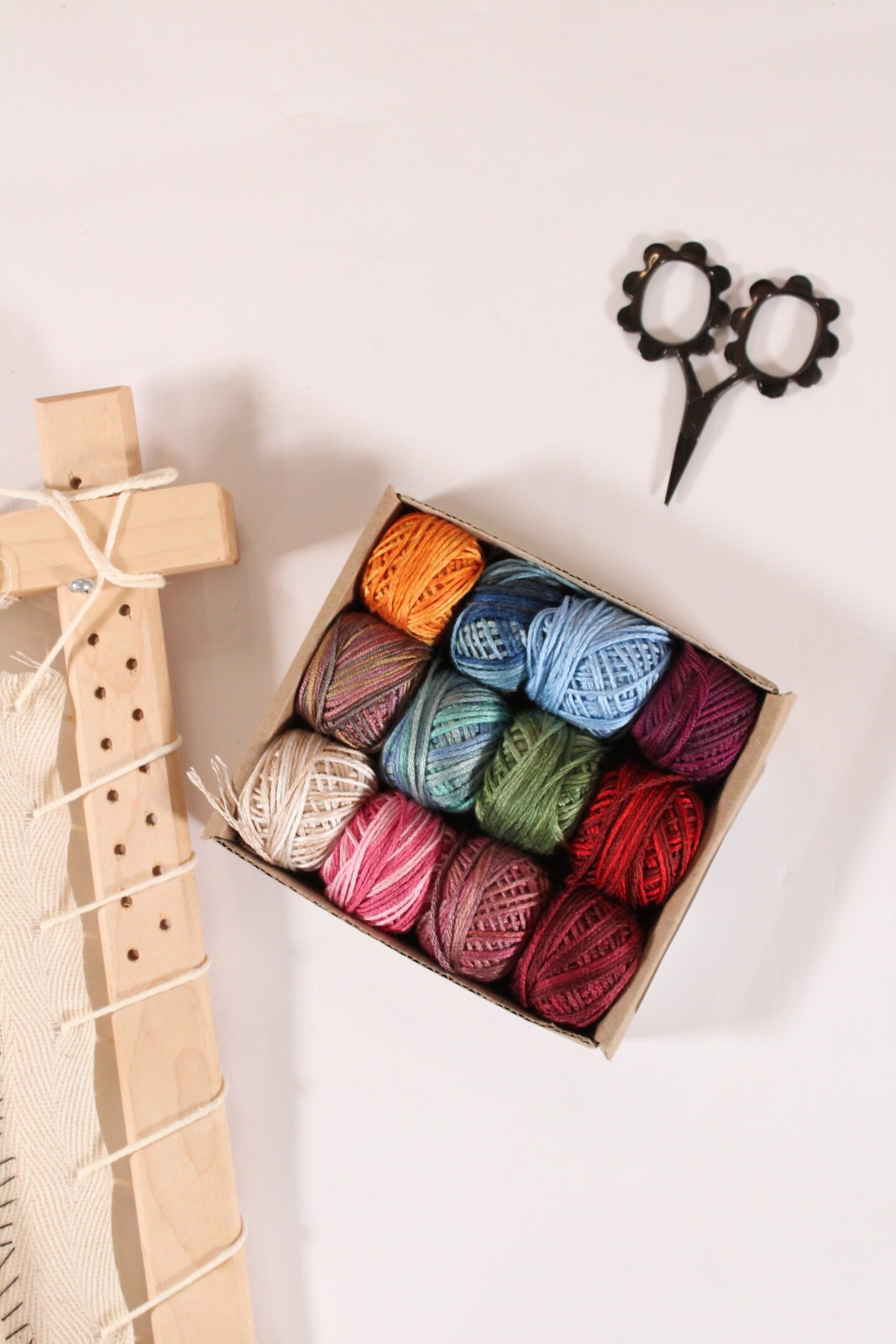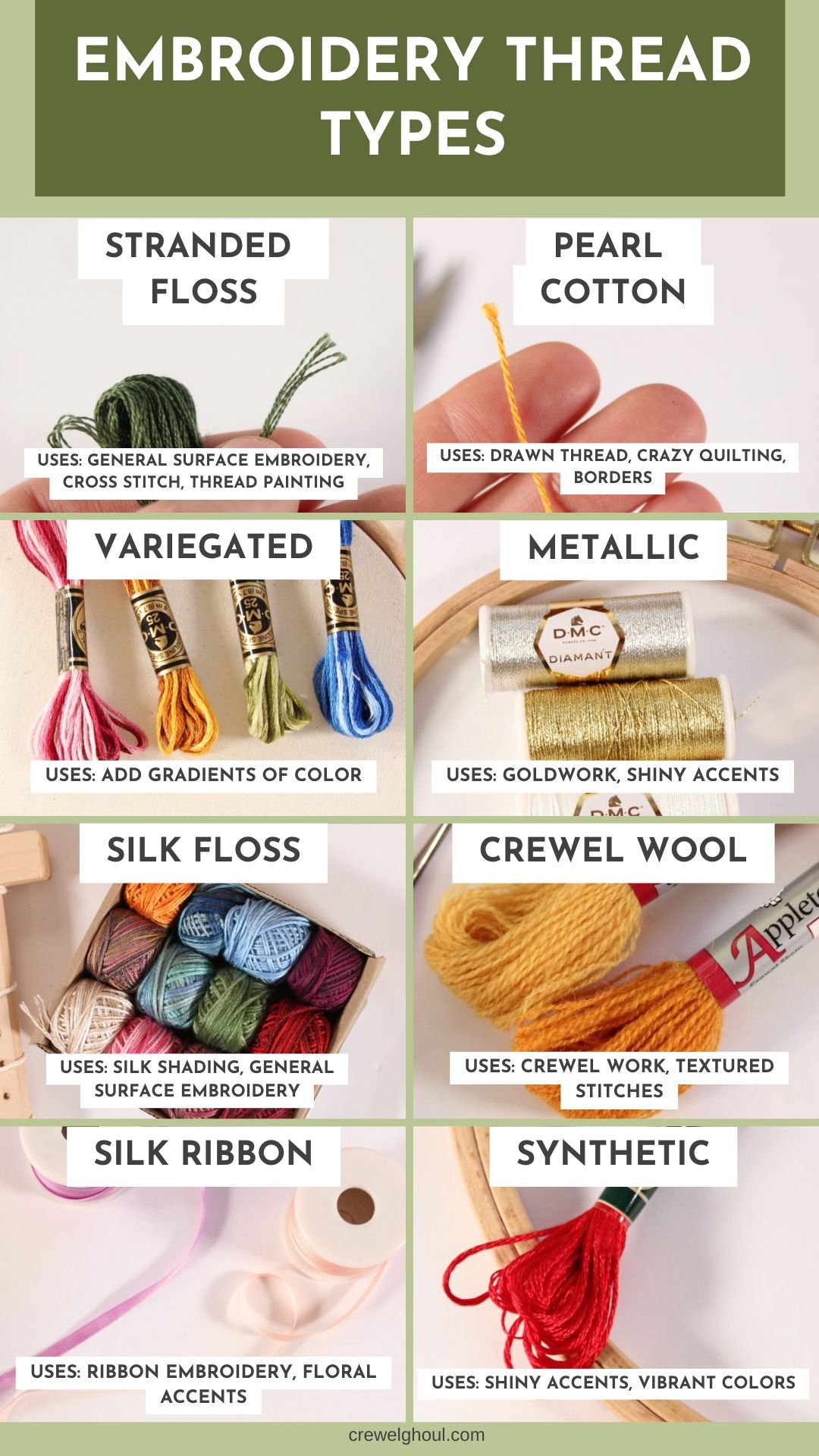Types of Hand Embroidery Threads & Choosing What To Use
There are a wide variety of different types of embroidery threads. While sticking with one kind is totally fine, it can be fun to incorporate something new into your embroidery every once in a while.
This post will share with you some of the different varieties. First, you’ll learn the lingo and some of the defining characteristics of different threads, then we’ll go over some of the different options and what they are commonly used for. By the end, you should feel confident in choosing the best type of thread for your next project!

Disclaimer: This post has some affiliate links in it. I receive a small commission from purchases at no additional cost to the buyer. I only recommend products I would use and love and that are of good quality. All opinions are my own!
Embroidery Thread Characteristics
Thread shopping can be overwhelming and confusing at first; There may be certain terms you’ll see on labels, and you may be thinking, “I have no idea what they means…”. So to make it easier, let’s go over some of the lingo.
If you’re already familiar with these, you can skip down to see all of the different types of thread.
Here are some of the defining characteristics that make up each type of thread:
- fiber type
- texture
- number of plies
- non-divisible vs separable strands
These characteristics make each kind of thread have a different and unique appearance.
Fiber
Threads come in many different types of fibers including wool, cotton, silk, acrylic, viscose, and rayon to name a few. Natural fibers are normally a bit easier to work with, but synthetic materials sometimes have their advantages.
Texture
Natural fibers tend to have more of a soft and pliable feel to them, whereas synthetic materials can be more rough, stiff, and slippery.
Number of Plies
Plies are the pieces of fibers that are twisted together to form a single strand of thread. While you can technically undo the plies of a strand of thread, it’s generally not recommended because it compromises the structure of the thread and weakens it.
Floss vs Thread – What’s the Difference?

Embroidery floss is made up of divisible strands of thread (usually 6). These 6 strands can be used all together or you can separate them strands and less.

Thread is generally made up of one non-divisible strand. If you look up close, you may notice that the thread looks like it is made up of a few different pieces of fiber. This is the amount of plies or fibers that are spun together to create the strand of thread.
Embroidery thread and yarns are most commonly 2-5 ply.
Yarn vs Thread – Are They The Same?
Yarn is a type of non-divisible thread that is spun/twisted together. For the sake of simplicity, the fibers that make up yarn are usually thicker than the fibers in thread that people refer to as “embroidery thread” (for example: pearl cotton thread).

Types of Embroidery Thread
6 Strand Embroidery Floss

One of the most common types of thread used for hand embroidery is stranded cotton embroidery floss. This floss is comprised of 6 strands of thread.
This type of thread is commonly used in many kinds of surface embroidery due to it’s versatility, durability, and large amount of color choices.
All 6 strands can be threaded on a needle and used together. Or the strands can be pulled apart and used separately depending on how thick or thin you want your embroidery stitches to be. This makes it a great option for fine, detailed work such as with thread painting techniques.
Two strands of embroidery floss is commonly used for cross-stitch projects.
So, is there a correct amount of strands to use? There are no set rules. It really depends on the technique you’re using and the look you’re going for!
Pearl Cotton Embroidery Thread

The next type of thread is pearl cotton thread. This rope-like thread is made up of 2-ply thread that is non-divisible. It is made of cotton and comes in a variety of thicknesses (3, 5, 8, and 12).
For more complicated embroidery stitches that are more intricate and decorative, this thread can be easier to use. (Sometimes with stranded thread, it starts to unravel or one of the strands can get snagged.)
Pearl cotton is a popular choice for embroidered quilts and drawn thread work. And some people use pearl thread simply because they like the way it looks!
Variegated Floss

Variegated floss is a stranded cotton floss that contains gradients of colors. Use it for embroidering letters, borders, or filling in an area; basically anywhere you want to add interesting color changes without having to switch to a different color. Visit this post for more variegated floss ideas.
Rayon Floss

If you’re looking for thread that has more of a satin finish, you can use stranded satin thread. Similar to stranded cotton floss, this thread is divisible. However, this thread is super silky and slippery. The strands tend to separate easily, so I’d recommend only using a few at a time instead of all 6 strands. It’s extremely beautiful and adds a brilliant pop of color!
Note: Due to it’s texture, it may not be ideal for stitching on clothes because the threads may be difficult to knot and secure.
DMC Light Effects

Light Effects is a shimmery synthetic floss made of polyester that has a pearlescent glow. It is phenomenal for making embroidery appear more sparkly and vibrant. It can be really stiff and hard to work with when you use all 6 strands. Try using 1 to 2 strands or combining it with cotton floss.
Etoille Thread

Etoille is neat because it’s made of cotton floss that has metallic thread mixed in. It makes the floss more fluffy and textured, and it’s a lot easier to work with than floss made up entirely of metallic/synthetic threads.
Diamant

DMC Diamant is a metallic-like thread that can be used by itself or combined with other kinds of threads and flosses to add some shine. I have found that this is by far the easiest synthetic thread to work with and it comes in a variety of basic colors.
I love adding a little bit of this for stitching stars or for small shiny accents like the glasses in this cat embroidery pattern.
Crewel Wool

Used for crewel embroidery work, this thread normally comes in 2-ply wool. It is thicker than the previous threads mentioned and the threads are non-divisible. Its texture is chunky and fluffy which adds a lot of dimension when used. Appleton’s and Zollie’s Array yarn are some of my favorites.
Tapestry Yarn

An even thicker kind of wool thread is tapestry yarn. In order to properly thread the needle, you’ll need to use a crewel or chenille needle with this yarn. It’s ideal for tapestry and needlepoint projects, but it’s also possible to use it in surface embroidery to add a even more dimension to your work.
Ribbon

Ribbon is used for ribbon embroidery, and it can be really fun to use for florals and leaves. The best type of ribbon for embroidery is silk ribbon because of how soft and pliable it is. This makes it easier to pull the needle and thread through the fabrics.
It is possible to embroider with synthetic ribbon, but it’s slippery and sometimes not as malleable, making it more challenging to use.
Ribbon comes in a variety of widths that are measured in millimeters. Choose a variety of sizes so you have a good amount of options to work with!
Silk Thread

This type of thread is traditionally used for silk shading or thread painting. As the name suggests, it’s made of silk and the fibers can be very fine to make blending colors a breeze. It can be a bit more expensive and harder to find, but it’s such a dream to stitch with. I used Valdani threads (pictured above) to embroider a fish.
Embroidery Thread Chart

Conclusion
I hope this information was helpful! Now that you’ve learned about all of the different kinds of fibers you can use to embroider, you may have one that you’d like to purchase! Check out this post that shows you how to find the best quality embroidery thread.
FAQs
Technically, yes you can! Sewing thread comes in different weights, colors, and fibers just like embroidery floss does. However, sewing thread is generally finer than embroidery thread and there aren’t always as many color / style options to choose from compared to embroidery thread brands such as DMC. While you can surely embroider with sewing thread, you may find that embroidery thread opens up a lot more options for you!
This depends on what kind of embroidery thread you are using! Cross stitch usually uses stranded cotton floss, which is very commonly used also in surface embroidery so there is some crossover. However, surface embroidery can use a wider variety of styles and fibers that are not commonly used in cross stitch.
Amanda is a hand embroidery teacher and artist. With over 15 years of experience in the craft industry and embroidery, she owns and runs Crewel Ghoul, sharing accessible tutorials and patterns to help inspire fellow crafters to get creative. In addition to running this website, she teaches on Skillshare and Youtube.



![Hand Embroidery Needle Sizes Explained [With Needle Size Chart]](https://crewelghoul.com/wp-content/uploads/2023/08/embroidery-needle-sizes-3-scaled.jpg)







I was just researching this last night!!! I’ve jumped into a project that started to be over whelming; I’m now stepping back for perspective. LIFE!!!
Please know that I am thinking of you with gratitude.
Carol Brown
Rock Hill SC
I’m so glad you found found this helpful. Good luck with your project, you’ve got this!